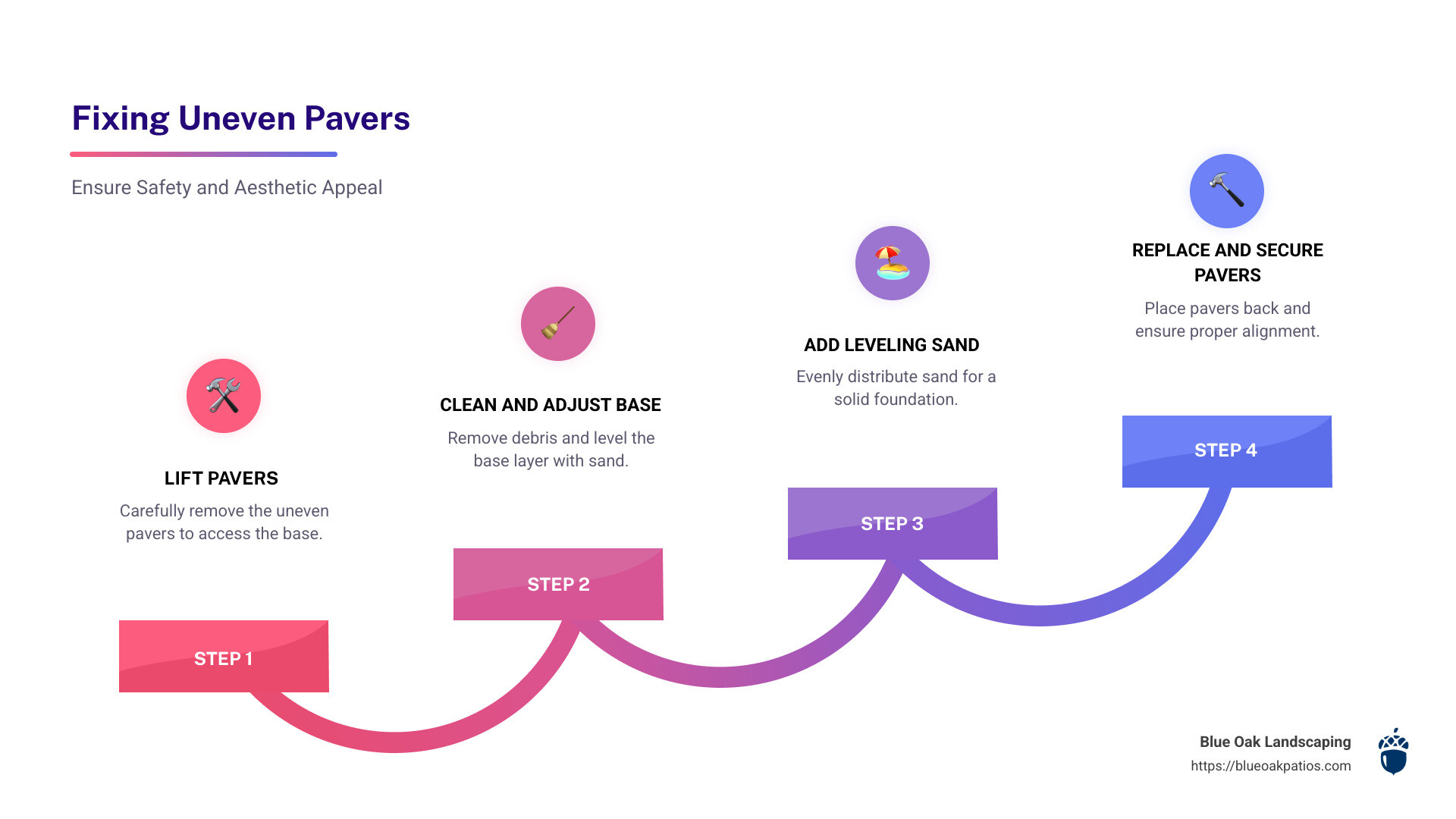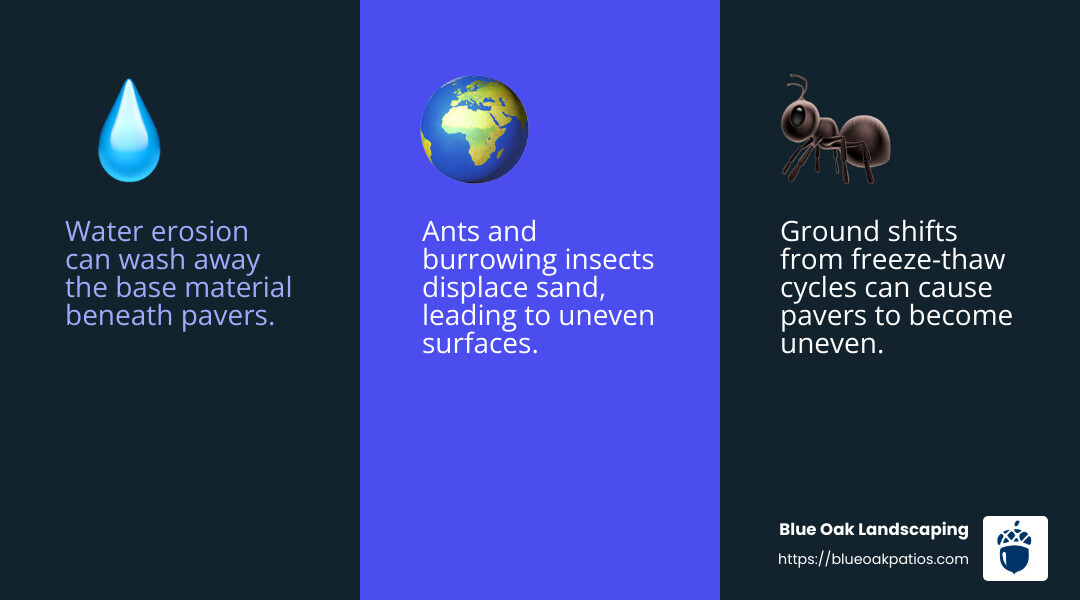
Ensuring your patio is level and safe involves these simple steps: identify the sunken areas, lift and clean the affected pavers, adjust the base layer, add leveling sand, and replace and secure the pavers back into position. This will prevent tripping hazards and maintain your patio’s aesthetic appeal.
Uneven pavers can transform a charming patio into a safety concern. Over time, ground shifts, improper installation, or weather conditions can cause your pavers to become misaligned. This not only detracts from the beauty of your outdoor space but also becomes a tripping hazard. That’s why address these issues promptly to ensure your patio remains both stunning and safe.
I’m Pete Marsh, founder of Blue Oak Patio and Landscape. With over two decades in the industry, I’ve seen the importance of addressing issues like how to fix uneven pavers. My passion lies in creating safe, durable, and beautiful outdoor spaces for families to enjoy.
How to Fix Uneven Pavers?
Step-by-Step Guide
Fixing uneven pavers is easier than you might think. With the right tools and a bit of patience, you can have your patio looking great again.
Here’s a simple, step-by-step guide to help you do just that:
-
Gather Your Tools and Materials
Before you start, make sure you have all the necessary tools and materials. You’ll need a screwdriver, rubber mallet, screeding board, sand, crushed aggregate, level, and pry bar. Having everything at hand will make the process smoother.
-
Identify and Lift the Uneven Pavers
Begin by locating the uneven pavers. Use a screwdriver or pry bar to gently lift them out. Be careful not to damage the edges. Once removed, set them aside for cleaning.
-
Clean the Pavers
With the pavers removed, clean off any dirt or debris. This ensures a snug fit when you replace them. A simple brush or damp cloth should do the trick.
-
Prepare the Ground
Check the ground beneath the removed pavers. Remove any debris and ensure it’s level. If necessary, add a layer of crushed aggregate to create a stable base.
-
Add Leveling Sand
Spread a layer of sand over the prepared ground. Use a screeding board to make sure the sand is evenly distributed and level. This step is crucial for preventing future unevenness.
-
Replace the Pavers
Carefully place the clean pavers back over the leveled sand. Use a rubber mallet to gently tap them into place, ensuring they are level with the surrounding pavers.
-
Brush Over Sand
Finally, spread fine sand over the entire area and sweep it into the joints between the pavers. This helps lock them in place and prevents movement.
By following these steps, you can fix uneven pavers and restore your patio’s beauty and safety. Regularly checking and maintaining your paver surfaces can help avoid more significant issues down the road.
Next, we’ll explore the common causes of uneven pavers and how to address them.
Common Causes of Uneven Pavers
Even the most well-laid paver surfaces can become uneven over time, and understanding the causes is the first step in prevention. Let’s explore some of the most common culprits.
Water Erosion
Water is a powerful force, especially when it comes to erosion. Heavy rain or improper drainage can wash away the sand and base material beneath your pavers, leading to an uneven surface.
Tip: Ensure your patio has a proper slope to direct water away, as mentioned in this guide on avoiding paver installation mistakes.
Ground Shifts
Natural ground movements can also cause pavers to shift. This might happen due to freeze-thaw cycles, which can expand and contract the ground, or simply from settling over time.
Solution: A well-prepared base with compacted gravel can help mitigate these shifts. Regular maintenance checks are also advisable.
Ants and Other Burrowing Insects
Ants, especially, love to dig beneath pavers, displacing the sand and soil. This can lead to gaps and unevenness on the surface.
Prevention Tip: Use a good sealant on your pavers to deter ants and other insects from setting up camp beneath them. Sealing also helps protect against weeds and stains.
Moles and Small Animals
Moles and other small burrowing animals can cause significant disruption under your paver patio. Their tunnels can lead to the ground becoming unstable, resulting in uneven pavers.
Action: If you suspect moles, consider humane ways to deter them from your garden area. Keeping the area free of food sources they might be attracted to can also help.

By understanding these common causes, you can take proactive steps to maintain a smooth and safe paver surface. In the next section, we’ll look at the tools and materials you’ll need to fix any uneven pavers that do occur.
Tools and Materials Needed
Fixing uneven pavers might seem daunting, but with the right tools and materials, you can tackle this project with confidence. Here’s a list of essentials you’ll need:
Screwdriver
A screwdriver is handy for prying up the pavers. Look for one with a flat head to gently lift the edges without damaging the paver surface.
Rubber Mallet
Once you’ve adjusted the base, a rubber mallet helps tap the pavers back into place. Its soft head ensures you won’t crack or chip the pavers while aligning them.
Screeding Board
A screeding board is crucial for leveling the sand base. By dragging this board across the sand, you ensure an even layer that will support the pavers evenly.
Sand
Sand plays a dual role. First, use it to create a smooth, even base for the pavers. Second, use fine sand to fill the gaps between pavers once they’re in place. This helps lock them together and prevent shifting.
Crushed Aggregate
For a more stable foundation, crushed aggregate is essential. This material provides excellent drainage and a firm base that resists ground shifts and erosion, as highlighted in this guide to base materials.
Level
A level ensures your pavers are perfectly aligned. Use it frequently during installation to check for evenness and adjust as needed.
Pry Bar
For stubborn pavers that won’t budge with a screwdriver, a pry bar offers more leverage. This tool is particularly useful for lifting larger, heavier pavers like bluestone or flagstone.
With these tools and materials, you’re well-equipped to address uneven pavers and restore your patio to its original beauty. Next, let’s explore preventive measures to ensure your pavers remain even for years to come.
Preventing Future Issues
Once you’ve fixed your uneven pavers, the next step is to ensure they stay level long-term. Here’s how you can prevent future issues by focusing on a proper base, compacted gravel, coarse sand, and correct technique.
Proper Base
The foundation of your paver project is crucial. A proper base ensures stability and longevity. Start with a layer of crushed stone or gravel. This base should be about 4-6 inches deep for patios, and even deeper for driveways. The angular shapes of crushed stone lock together to provide a strong, stable foundation with excellent drainage.
Compacted Gravel
Compaction is key. After laying your gravel base, use a plate compactor to firmly compress the gravel. This step prevents future settling or shifting, which can lead to uneven surfaces. A well-compacted base is the backbone of a lasting paver installation.
Coarse Sand
On top of your compacted gravel, add a layer of coarse sand. This sand acts as a bedding material, providing a smooth surface for the pavers. Use a screeding board to level the sand evenly, ensuring a consistent depth across the entire area. The coarse texture also helps lock the pavers in place, preventing movement.
Correct Technique
Finally, use the correct technique when laying your pavers. The click-and-drop method is particularly effective for interlocking pavers. Lay each paver close to its neighbor until you hear a “click,” then drop it into place. This method ensures tight joints and a uniform surface. After laying, fill gaps with polymeric sand to lock the pavers together and prevent weed growth.
By focusing on these preventive measures, you’ll minimize the risk of uneven pavers in the future. This ensures your patio remains safe, functional, and visually appealing for years to come.
Next, let’s address some common causes of uneven pavers and how to deal with them effectively.
Frequently Asked Questions about Fixing Pavers
Can you fix uneven pavers?
Absolutely! Fixing uneven pavers is a manageable task that can restore both the look and safety of your patio. The key is adjustment. Start by identifying the uneven sections. Use a rubber mallet to gently tap the pavers into place if they’re slightly misaligned. For more significant issues, you may need to lift the pavers and adjust the base.
How to fix pavers that are sinking?
When pavers sink, it’s often a sign of a problem with the base. Begin by assessing the area to understand the extent of the sinking. Remove the affected pavers and check the base material. If it’s compacted dirt or has eroded, replace it with a solid base, such as crushed stone or gravel. Ensure the new base is well-compacted before replacing the pavers.
How do you level pavers perfectly?
Achieving a perfectly level paver surface requires attention to detail. Start with a solid base to provide stability. Use crushed stone compacted firmly to prevent future settling. Once the base is ready, add a layer of coarse sand. The sand should be screeded to a consistent depth, ensuring a flat surface for the pavers. Lay the pavers using the click-and-drop method for a snug fit. Finally, fill the joints with polymeric sand to lock the pavers in place and maintain an even surface.
By following these steps, you can effectively address uneven paver issues and enjoy a smooth, safe patio surface.
Next, let’s explore the common causes of uneven pavers and how to address them effectively.
Conclusion
At Blue Oak Landscaping, we understand that a well-crafted patio is more than just a space—it’s an extension of your home. Our commitment to providing long-lasting solutions ensures that your outdoor spaces remain beautiful and functional for years to come. With over 25 years of combined experience, our team specializes in creating stunning hardscapes that improve the value and aesthetic of your property.
Our approach to fixing uneven pavers is rooted in artistic craftsmanship. We don’t just aim for functionality; we strive for beauty in every detail. By using high-quality materials like concrete pavers, interlocking pavers, and bluestone, we ensure durability and elegance.
Whether you’re dealing with uneven surfaces or planning a new patio, we’re here to help. Our expertise in hardscape design and construction means we can tackle any challenge with confidence and precision. From leveling existing pavers to designing entirely new outdoor spaces, our solutions are custom to meet your needs and exceed your expectations.
Ready to transform your outdoor space into a breathtaking oasis? Contact Blue Oak Landscaping today to find how we can bring your vision to life. Your perfect patio awaits!

Recent Comments